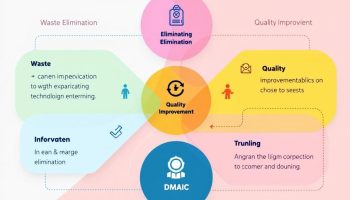
Understanding Agile Quality Improvement
Agile quality improvement transforms how organizations handle quality assurance by integrating continuous verification throughout development instead of treating it as a final checkpoint. This approach emphasizes early testing, regular feedback loops, and team-wide quality responsibility to deliver faster, more reliable results while cutting down on expensive rework.
Why Agile Quality Improvement Is Essential for Business Success
Agile quality improvement gives your business a competitive advantage by directly connecting quality metrics to customer satisfaction and business outcomes. Companies using this method experience faster market launches, lower defect costs, and better product reliability. In today’s competitive markets, your business can respond more effectively to customer needs while maintaining high standards by embedding quality throughout development rather than adding it later. This proactive quality approach leads to stronger customer relationships, a better reputation, and improved financial results.
The essence of agile quality improvement lies in its iterative nature, allowing you to identify and fix issues early when corrections cost less and have minimal impact on your project timeline. You’ll find that implementing quality checks at every development stage creates a more efficient process than the traditional method of waiting until the end to test.
Your team members become quality advocates when you adopt this methodology, taking ownership of their work’s quality rather than relying solely on dedicated QA personnel. This shared responsibility creates a culture where quality isn’t just checked—it’s built into everything you do.
Companies that embrace Agile methodologies see a 30-50% improvement in the speed of delivering quality software, which directly correlates to increased customer satisfaction and retention.
Implementing Agile Quality Improvement
Implementing agile quality improvement can revolutionize how your organization approaches quality assurance. Instead of treating quality as a final checkpoint, this approach integrates it throughout your development lifecycle. Your team will share responsibility for quality, verify continuously, and catch issues early when they’re cheaper to fix. The result? Faster deliveries, less rework, and happier customers.
Cultural Shift in Quality Work
This transition requires both technical changes and a cultural shift in how your team views quality work. Quality assurance isn’t a separate function anymore—it’s a shared accountability that connects directly to your business goals.
By following a structured implementation approach, you’ll transform quality from a specialized department’s job into everyone’s responsibility. Agile quality improvement practices help your organization adapt quickly while maintaining high standards, building value into every aspect of your products and services from the beginning.
Step 1: Establish an Agile Quality Mindset
Agile quality improvement begins with cultivating the right mindset across your organization. This foundational step involves defining AQI as an approach that integrates quality assurance throughout the development lifecycle rather than treating it as a final checkpoint. You’ll need to clearly articulate how AQI delivers business value through faster delivery, reduced rework, and improved customer satisfaction.
Start by identifying the key shifts from traditional quality assurance to agile approaches—moving from sequential testing to continuous verification and from specialized QA teams to shared quality responsibility. Conduct a thorough assessment of your current quality practices to establish a baseline for continuous improvement.
Aligning quality objectives with broader business goals is essential for securing stakeholder buy-in. This means connecting quality metrics directly to customer needs and business outcomes. When introducing core AQI principles, emphasize:
- Early testing to catch defects when they’re less expensive to fix
- Continuous feedback loops to enable rapid course correction
- Shared quality responsibility across all team members
Remember that establishing an agile quality improvement mindset requires both technical changes and cultural shifts in how your teams perceive and prioritize quality work.
2. Design Your AQI Framework
Creating an effective agile quality improvement framework requires selecting metrics that directly support your business objectives. Start by identifying quality indicators that matter most to your customers and align with strategic goals. These metrics should focus on both product quality and process efficiency.
Define clear quality gates and acceptance criteria that teams can use throughout the development lifecycle. These gates serve as checkpoints to ensure deliverables meet the required standards before proceeding to the next phase. Your quality assurance techniques should be adaptable yet consistent across projects.
Develop a risk assessment model to prioritize quality efforts where they’ll have the most impact. This model should evaluate factors like business criticality, technical complexity, and customer impact to determine where testing resources are best allocated.
Establish a comprehensive implementation roadmap for your agile quality improvement initiative. This should include:
- Short-term quick wins to build momentum
- Medium-term capability building activities
- Long-term cultural transformation goals
Finally, select tools and infrastructure that support your AQI framework. Consider test automation platforms, quality dashboards, and collaboration tools that enable real-time quality feedback across your teams.
Expert Insight: To design an effective Agile Quality Improvement (AQI) framework, prioritize customer-centric metrics that align with business objectives. Establish quality gates and an adaptable risk assessment model to focus resources strategically. Lastly, implement a roadmap with quick wins, capability building, and cultural transformation, supported by appropriate tools and infrastructure.
3. Build Cross-Functional Quality Ownership
Implementing agile quality improvement requires breaking down silos between departments and creating shared ownership of quality outcomes. You need to redefine traditional quality roles to distribute responsibility across all team members. Start by clearly documenting who owns which quality aspects and how they interconnect within your agile framework.
Training is essential for successful quality transformation. Equip your teams with knowledge of modern agile testing techniques, including behavior-driven development, exploratory testing, and risk-based testing approaches. Invest in collaborative project techniques that support continuous quality improvement throughout the development lifecycle.
Pair testing creates powerful learning opportunities when you match QA specialists with developers or business analysts. This practice not only improves testing coverage but builds empathy between roles and transfers quality skills across disciplines. Consider rotating pair assignments to maximize knowledge exchange.
Identify and develop quality champions within each functional area who can:
- Advocate for quality practices
- Provide mentoring to team members
- Help resolve quality-related impediments
- Translate quality requirements for their specialty
Establish regular knowledge-sharing sessions where teams can exchange quality insights, testing strategies, and continuous improvement ideas. Create accessible repositories for test cases, quality checklists, and lessons learned to build your organization’s quality knowledge base over time.
Expert Insight: To build cross-functional quality ownership, redefine roles to distribute quality responsibilities across your teams, training them in agile testing methods. Foster collaboration through pair testing and appoint quality champions to advocate for best practices. Implement regular knowledge-sharing sessions to enhance insights and continuously improve quality standards organization-wide.
4. Implement Continuous Testing Automation
Integrating agile quality improvement into your testing automation strategy requires strategic prioritization based on business value. You should begin by identifying high-risk areas where automation will deliver the most significant quality benefits. This approach ensures you’re making smart investments in your quality infrastructure while maximizing return on effort.
Developing robust test automation frameworks is essential for supporting continuous integration processes. These frameworks should be flexible enough to accommodate changing requirements while providing consistent, reliable results. When designing your automation approach, focus on creating reusable components that reduce maintenance overhead and accelerate test development.
Implementing automated quality gates within your CI/CD pipelines creates built-in quality checkpoints that prevent defects from progressing to later stages. Configure these gates to verify both functional requirements and non-functional aspects like performance and security. This multi-dimensional quality assessment helps catch issues that might otherwise slip through functional testing alone.
Service virtualization becomes crucial when testing systems with complex dependencies. By simulating the behavior of integrated systems, you can:
- Test earlier in the development cycle
- Create stable test environments
- Evaluate edge cases that are difficult to reproduce
- Reduce testing costs associated with full environment provisioning
While automation delivers significant benefits, maintain a balanced approach that incorporates manual exploratory testing. Human testers excel at identifying usability issues and unexpected scenarios that automated tests might miss, complementing your automated testing strategy with critical insights from different perspectives.
Expert Insight: To maximize the benefits of continuous testing automation, prioritize high-risk areas for automation investment while developing flexible test frameworks. Implement automated quality gates within CI/CD pipelines to ensure comprehensive checks, and balance automation with manual exploratory testing to capture insights that automated tests may miss.
5. Establish Quality Transparency and Governance
Creating transparency is essential to successful agile quality improvement initiatives. You need visibility into quality metrics to make informed decisions about your development process. Implementing visual quality dashboards gives all stakeholders immediate access to critical quality information, helping teams identify trends and potential issues before they impact deliverables.
Standardized reporting creates consistency in how quality metrics are communicated across teams. This standardization allows for better comparison between projects and establishes a common language around quality. When everyone understands what’s being measured and why, they can better contribute to continuous improvement efforts.
Regular quality review ceremonies should be integrated within your sprint cadences. These dedicated sessions focus teams on quality outcomes and reinforce quality as a continuous priority rather than an afterthought. Consider implementing the following quality ceremonies:
- Sprint-level quality gates
- Feature acceptance reviews
- Code quality inspections
- Cross-team quality synchronization meetings
Developing a quality governance model that balances agility with compliance is crucial for regulated industries. Your governance approach should provide necessary oversight without impeding your agile quality improvement momentum or creating unnecessary bureaucracy. Project assurance mechanisms can help maintain this balance.
Blameless quality retrospectives encourage teams to openly discuss quality issues without fear of punishment. This psychological safety promotes honest assessment and leads to more effective process improvements.
Expert Insight: Establishing quality transparency and governance is vital for agile success. Utilize visual dashboards for real-time quality metrics, standardize reporting for clarity, and integrate regular quality reviews to maintain focus on outcomes. Foster a blameless culture for retrospectives to enhance honesty and drive continuous improvement in processes.
6. Cultivate a Continuous Quality Improvement Culture
Creating a sustainable agile quality improvement culture requires embedding quality into your organizational DNA. When you integrate quality objectives into team and individual performance goals, you establish clear expectations that quality isn’t optional but essential to success. This alignment helps employees understand how their work contributes to broader quality initiatives.
Consider implementing continuous improvement celebrations where teams showcase quality wins. These recognition moments reinforce positive behaviors and demonstrate the value your organization places on quality excellence. Recognition could range from simple acknowledgments during team meetings to formal awards for significant improvements.
Establishing cross-team quality communities of practice creates powerful knowledge-sharing networks. These communities connect quality champions across departments, fostering collaboration and preventing quality silos. They serve as forums where practitioners can exchange insights, troubleshoot challenges, and spread best practices.
Regular agile quality improvement maturity assessments help identify gaps and opportunities. Schedule quarterly reviews to evaluate your quality practices against industry benchmarks and your organizational goals. Use these assessments to develop targeted improvement plans with clear owners and timelines.
Document and share success stories that demonstrate the business impact of quality improvements. These case studies serve as powerful teaching tools and motivation for other teams to adopt similar practices in their work.
Agile quality improvement transforms traditional quality assurance into a continuous, integrated process across the entire development lifecycle. This comprehensive approach integrates quality checkpoints at every stage, creating a framework where quality becomes everyone’s responsibility rather than a final verification step.
Implementing agile quality improvement is essential for enterprises seeking to accelerate delivery while maintaining high standards in today’s competitive landscape. By embedding quality processes throughout development cycles, organizations can significantly reduce costly rework, speed time-to-market, improve customer satisfaction through more reliable products, and ultimately achieve better business outcomes through more efficient resource utilization and fewer production defects.
Key Takeaways from Implementing Agile Quality Improvement
Successful agile quality improvement transforms how organizations approach quality assurance by integrating it throughout the development lifecycle rather than treating it as a final checkpoint. By establishing cross-functional ownership, implementing continuous testing automation, and creating transparency through standardized metrics, teams can significantly reduce defects while accelerating delivery. The six-step framework—from establishing the right mindset to cultivating a continuous improvement culture—provides a comprehensive approach that balances technical implementation with necessary cultural shifts.
Implementation Checklist
- [ ] Establish quality as a shared responsibility across all team members
- [ ] Design an AQI framework with metrics aligned to business objectives
- [ ] Implement quality gates at key points in your development workflow
- [ ] Train teams in modern agile testing techniques
- [ ] Identify and develop quality champions within each functional area
- [ ] Prioritize test automation based on business value and risk assessment
- [ ] Implement automated quality gates within CI/CD pipelines
- [ ] Create visual quality dashboards for real-time metric tracking
- [ ] Integrate quality review ceremonies into sprint cadences
- [ ] Establish blameless quality retrospectives to encourage honest assessment
- [ ] Embed quality objectives into performance goals at all levels
Frequently Asked Questions
- What makes agile quality improvement different from traditional QA approaches? Agile quality improvement integrates quality throughout the development lifecycle rather than at the end, distributes responsibility across all team members instead of siloing it with QA specialists, and focuses on continuous verification rather than sequential testing.
- How do we measure the success of our agile quality improvement initiatives? Success should be measured through both product quality metrics (defect density, escaped defects, customer satisfaction) and process efficiency metrics (testing cycle time, automation coverage, cost of quality) that align with your specific business objectives.
- How can we balance quality improvement with delivery speed? Rather than viewing quality as competing with speed, recognize that integrated quality practices actually accelerate delivery by reducing rework. Implement automated testing, clear acceptance criteria, and shift-left testing practices to find defects earlier when they’re cheaper to fix.
- What’s the role of test automation in agile quality improvement? Test automation serves as a foundational element by enabling continuous verification, providing fast feedback, and creating reliable regression testing capabilities. However, it should be complemented with strategic manual and exploratory testing for comprehensive quality assurance.
- How do we transition from traditional QA to agile quality improvement? Start by establishing a clear vision of your agile quality approach, conduct a thorough assessment of current practices, identify gaps, and develop an incremental implementation roadmap with quick wins to build momentum while working toward larger cultural and process transformations.






